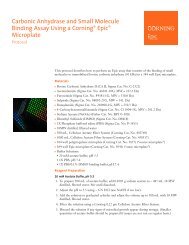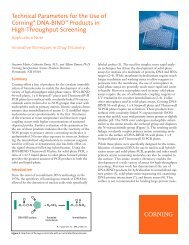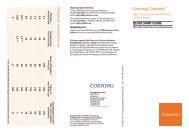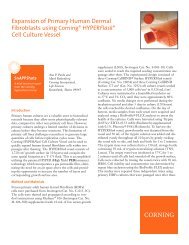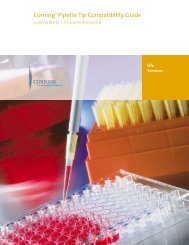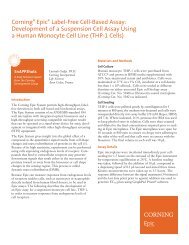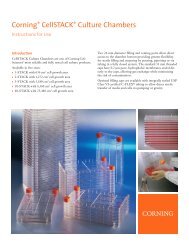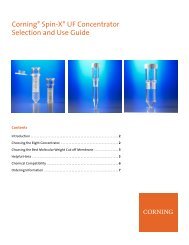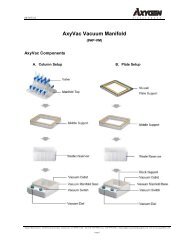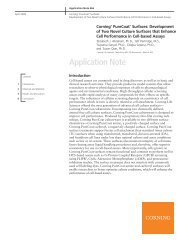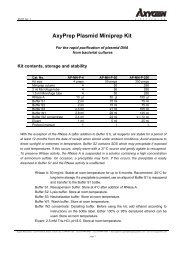AxyPrep Bacterial Genomic DNA Miniprep Kit
AxyPrep Bacterial Genomic DNA Miniprep Kit
AxyPrep Bacterial Genomic DNA Miniprep Kit
Create successful ePaper yourself
Turn your PDF publications into a flip-book with our unique Google optimized e-Paper software.
05/11 Ver. 1<br />
<strong>AxyPrep</strong> <strong>Bacterial</strong> <strong>Genomic</strong> <strong>DNA</strong> <strong>Miniprep</strong> <strong>Kit</strong><br />
For the purification of genomic <strong>DNA</strong> from bacterial samples<br />
<strong>Kit</strong> contents, storage and stability<br />
Cat. No. AP-MN-BT-G<strong>DNA</strong>-50 AP-MN-BT-G<strong>DNA</strong>-250<br />
<strong>Kit</strong> size 50 preps 250 preps<br />
<strong>Miniprep</strong> column 50 250<br />
Spin-filter 50 250<br />
2 ml Microfuge tube 150 750<br />
1.5 ml Microfuge tube 50 250<br />
RNase A 20 μl 100 μl<br />
Lysozyme 60 mg 2×140 mg<br />
Buffer S 10 ml 50 ml<br />
0.25 M EDTA 2 ml 10 ml<br />
Buffer G-A 26 ml 130 ml<br />
Buffer G-B 26 ml 125 ml<br />
Buffer DV (empty) 1 1<br />
Buffer DV-A 5 ml 10 ml<br />
Buffer BV 25 ml 125 ml<br />
Buffer W1 28 ml 135 ml<br />
Buffer W2 concentrate 24 ml 2×72 ml<br />
Eluent 12 ml 60 ml<br />
Protocol manual 1 1<br />
Except for the RNase A (after addition to Buffer S) and the lysozyme, all buffers and reagents are<br />
stable for a period of at least 12 months from the date of receipt when stored under ambient<br />
conditions. Please avoid exposure to direct sunlight or extremes in temperature. To preserve RNase<br />
activity, the RNase A is suspended in a solution containing a high concentration of ammonium sulfate.<br />
On occasion, a precipitate may form. If this occurs, the precipitate is easily dissolved in Buffer S and<br />
the RNase activity is unaffected.<br />
RNase A: 50 mg/ml. Stable at room temperature for up to 6 months. Recommend -20°C for<br />
long-term storage. If a precipitate is visible, use a small aliquot of Buffer S to<br />
dissolve and transfer to the Buffer S bottle.<br />
Lysozyme: Dissolved in sterile 50% glycerol to a final concentration of 50mg/ml. The<br />
dissolved lysozyme is stable for 6 months when stored at -20°C.<br />
Buffer S: <strong>Bacterial</strong> protoplast preparation buffer. After addition of RNase A, mix well and<br />
store at 4°C. The dissolved RNase A is stable for 6 months when Buffer S is<br />
stored at 4°C.<br />
0.25 M EDTA: Store at room temperature.<br />
Buffer G-A: Lysis buffer. Store at room temperature.<br />
Axygen Biosciences 33210 Central Avenue, Union City, CA 94587 USA Tel:510-494-8900 Fax: 510-494-0700 e-mail:info@axygen.com web:www.axygenbio.com<br />
page 1
05/11 Ver. 1<br />
Buffer G-B: Protein-removal buffer. Store at room temperature.<br />
Buffer DV-A: Buffer DV additive. Used for preparation of Buffer DV (refer to Preparation<br />
before experiment on page 3 for details). Store at room temperature.<br />
Buffer DV: Phase-partition buffer. Store at room temperature. Prepare by following the<br />
instructions described in “Preparation Before Experiment” on page 3 of this<br />
manual.<br />
Buffer BV: <strong>DNA</strong> binding buffer. Store at room temperature.<br />
Buffer W1: Wash buffer. Store at room temperature.<br />
Buffer W2 concentrate: Desalting buffer. Before using the kit, add ethanol according to<br />
instructions on the bottle label. Either 100% or 95% denatured ethanol can be<br />
used. Store at room temperature.<br />
Eluent: 2.5 mM Tris-HCl, pH 8.5. Store at room temperature.<br />
Introduction<br />
The isolation of bacterial genomic <strong>DNA</strong> by this kit is based upon the efficient release of genomic <strong>DNA</strong><br />
by a special cell lysis buffer, Buffer G-A. Following this, rapid separation of the genomic <strong>DNA</strong> from<br />
proteins, polysaccharides and lipids is achieved by a unique phase-partitioning step. Highly purified<br />
genomic <strong>DNA</strong> in the lower phase is then selectively bound to a special <strong>Miniprep</strong> column. After<br />
washing successively with Buffer W1 and Buffer W2 to remove residual impurities and salt, the<br />
purified bacterial genomic <strong>DNA</strong> is eluted from the <strong>Miniprep</strong> column in Tris buffer or water. This kit is<br />
suitable for the rapid isolation of up to 20 μg of genomic <strong>DNA</strong> from 1.0×10 9 bacterial cells. The<br />
purified <strong>DNA</strong> is predominantly ≥ 30 kb in length, and is suitable for a varitey of applications<br />
demanding highly purified, high molecular weight genomic <strong>DNA</strong>, such as PCR, Southern blot analysis,<br />
RAPD, AFLP and RFLP, etc.<br />
Caution<br />
Buffer G-B, Buffer BV and Buffer W1 contain chemical irritants. When working with the buffers,<br />
always wear suitable protective clothing such as safety glasses, laboratory coat and gloves. Be<br />
careful to avoid contact with eyes and skin. In the case of such contact, wash immediately with water.<br />
If necessary, seek medical assistance.<br />
Equipment and consumables required<br />
• Heated water bath<br />
• AxyVac Vacuum manifold (#AP-VAC) or comparable model<br />
• Vacuum regulator<br />
• Vacuum source (-25-30 inches Hg required)<br />
• Microcentrifuge capable of 12,000×g<br />
• 100% or 95% (denatured) ethanol<br />
• Isobutanol & Isopropanol<br />
Axygen Biosciences 33210 Central Avenue, Union City, CA 94587 USA Tel:510-494-8900 Fax: 510-494-0700 e-mail:info@axygen.com web:www.axygenbio.com<br />
page 2
05/11 Ver. 1<br />
Preparation before experiment<br />
1) Before using the kit, add the amount of ethanol specified on the bottle label to the Buffer W2<br />
concentrate. Either 100% or 95% denatured ethanol can be used.<br />
2) Prepare Buffer DV: Add 2 ml of Buffer DV-A, 125 ml of isopropanol and 75 ml of isobutanol to the<br />
250-ml bottle provided with kit and mix well.<br />
3) Chill Buffer DV at 4°C before experiment.<br />
4) Dissolve lysozyme in 50% glycerol before using the kit.<br />
5) Add RNase A into Buffer S and mix well.<br />
Note: If a precipitate is present, use a small volume of Buffer S to resuspend the RNase A and the transfer to the<br />
Buffer S bottle.<br />
6) Switch on the water bath and just to 65°C.<br />
7) Check Buffer G-A and Buffer G-B for precipitation before each use. If precipitation occurs, warm<br />
at 65°C to dissolve the precipitate, then equilibrate to room temperature before use.<br />
8) Pre-warming the Eluent to 65°C will often improve elution efficiency.<br />
Protocols<br />
Please read through the entire protocol, including the “Notes”, carefully before proceeding. <strong>Genomic</strong><br />
<strong>DNA</strong> can be purified from either gram- or gram+ bacterial strains with this procedure.<br />
<strong>Bacterial</strong> <strong>Genomic</strong> <strong>DNA</strong> <strong>Miniprep</strong> vacuum protocol<br />
A vacuum manifold, such as AxyVac Vacuum manifold with complementary fittings which can<br />
accommodate the <strong>Miniprep</strong> column is required for Steps 10-12. A Vacuum of –25-30 inches Hg is<br />
required. -25-30 inches Hg is approximately equivalent to -850-1,000 mbar and -12-15 psi.<br />
1. Collect 1×10 9 bacteria in a 2 ml Microfuge tube (provided). Spin at top speed (12,000×g) for 30<br />
seconds. Discard the supernatant and resuspend the bacterial pellet in 150 μl of Buffer S,<br />
containing RNase A.<br />
Note: Make sure that RNase A has been added into Buffer S.<br />
Note: Be sure that the bacterial pellet is homogenously resuspended. Aggregates and clumps will reduce lysis<br />
efficiency and yield.<br />
Note: 1×10 9 bacteria is equivalent to 1 ml of bacterial culture at OD 600 =1-1.5<br />
2. Add 20 μl of lysozyme and mix well. Allow to sit at room temperature for 5 minutes before<br />
proceeding.<br />
Note: When using gram+ bacteria, incubate at 37°C for 30 minutes, following the addition of lysozyme.<br />
3. Add 30 μl of 0.25 M EDTA (pH 8.0). Mix well and incubate on ice for 5 minutes.<br />
4. Add 450 μl of Buffer G-A and vortex for 15 seconds. Heat in a water bath at 65°C for 10 minutes.<br />
5. Add 400 μl of Buffer G-B, followed by 1 ml of Buffer DV (pre-chilled to 4°C). Mix vigorously.<br />
Centrifuge at 12,000×g for 2 minutes.<br />
Note: Please refer to “Preparation before experiment” on page 3 to prepare Buffer DV.<br />
Axygen Biosciences 33210 Central Avenue, Union City, CA 94587 USA Tel:510-494-8900 Fax: 510-494-0700 e-mail:info@axygen.com web:www.axygenbio.com<br />
page 3
05/11 Ver. 1<br />
6. Aspirate off as much of the upper phase as possible, without disturbing the interphase. Discard<br />
the upper phase.<br />
7. Add 1 ml of Buffer DV (pre-chilled to 4°C) to the remaining interphase and lower phase. Mix<br />
vigorously to achieve homogeneity and centrifuge at 12,000×g for 2 minutes.<br />
8. Discard the colored upper phase. Transfer the lower phase to a Spin-filter, placed into a 2 ml<br />
Microfuge tube (provided) and centrifuge at 12,000×g for 1 minute.<br />
Note: When recovering the lower phase, complete removal of the upper phase is not necessary. Any of the<br />
upper phase which is carried over will rapidly shift to the top of the pipette tip and can easily be removed<br />
(Refer to the figure below).<br />
Note: If the lower phase is transferred without any contaminating interphase debris, Step 8 can be omitted.<br />
Pipette<br />
lower phase<br />
Phase partition<br />
inside Tip<br />
Transfer lower<br />
phase into Spin-filter<br />
Discard<br />
upper phase<br />
Note: Avoid carryover of upper phase liquid. This will cause inhibition of genomic <strong>DNA</strong> binding to the <strong>Miniprep</strong><br />
column (Step 9, below).<br />
9. Discard the Spin-filter. Add 400 μl of Buffer BV to the filtrate and mix well.<br />
10. Attach the vacuum manifold base to a vacuum pump. Transfer the binding mix from Step 9 to<br />
the <strong>Miniprep</strong> column. Turn on the vacuum source and adjust to –25-30 inches Hg. Draw all<br />
solution through the <strong>Miniprep</strong> column.<br />
11. Add 500 μl of Buffer W1 and draw the solution through the column.<br />
12. Add 700 μl of Buffer W2 along the wall of <strong>Miniprep</strong> column to wash off any residual Buffer W1<br />
and draw through the column. Wash once again with 700 μl of Buffer W2.<br />
Note: Make sure that ethanol has been added into Buffer W2 concentrate.<br />
Note: Add Buffer W2 along the tube wall to wash off any residual salt.<br />
13. Place the <strong>Miniprep</strong> column into a 2 ml Microfuge tube. Centrifuge at 12,000×g for 1 minute.<br />
Note: Two washes with Buffer W2 are used to ensure the complete removal of salt, eliminating potential<br />
problems in subsequent enzymatic reactions.<br />
14. Transfer the <strong>Miniprep</strong> column into a clean 1.5 ml Microfuge tube (provided). To elute the <strong>DNA</strong>,<br />
add 100-200 μl of deionized water or Eluent to the center of the membrane. Let it stand for 1<br />
minute at room temperature. Centrifuge at 12,000×g for 1 minute.<br />
Note: Pre-warming water or Eluent at 65°C will often improve elution efficiency.<br />
Axygen Biosciences 33210 Central Avenue, Union City, CA 94587 USA Tel:510-494-8900 Fax: 510-494-0700 e-mail:info@axygen.com web:www.axygenbio.com<br />
page 4
05/11 Ver. 1<br />
<strong>Bacterial</strong> <strong>Genomic</strong> <strong>DNA</strong> <strong>Miniprep</strong> spin protocol<br />
1. Collect 1×10 9 bacteria in a 2 ml Microfuge tube (provided). Spin at top speed (12,000×g) for 30<br />
seconds. Discard the supernatant and resuspend the bacterial pellet in 150 μl of Buffer S,<br />
containing RNase A.<br />
Note: Make sure that RNase A has been added into Buffer S.<br />
Note: Be sure that the bacterial pellet is homogenously resuspended. Aggregates and clumps will reduce lysis<br />
efficiency and yield.<br />
Note: 1×10 9 bacteria is equivalent to 1 ml of bacterial culture at OD 600 =1-1.5.<br />
2. Add 20 μl of lysozyme and mix well. Allow to sit at room temperature for 5 minutes before<br />
proceeding.<br />
Note: When using gram+ bacteria, incubate at 37°C for 30 minutes, following the addition of lysozyme.<br />
3. Add 30 μl of 0.25 M EDTA (pH 8.0). Mix well and incubate on ice for 5 minutes.<br />
4. Add 450 μl of Buffer G-A and vortex for 15 seconds. Heat in a water bath at 65°C for 10 minutes.<br />
5. Add 400 μl of Buffer G-B, followed by 1 ml of Buffer DV (pre-chilled to 4°C). Mix vigorously.<br />
Centrifuge at 12,000×g for 2 minutes.<br />
Note: Please refer to “Preparation before experiment” on page 3 to prepare Buffer DV.<br />
6. Aspirate off as much of the upper phase as possible without disturbing the interphase. Discard<br />
the upper phase.<br />
7. Add 1 ml of Buffer DV (pre-chilled to 4°C) to the remaining interphase and lower phase. Mix<br />
vigorously to achieve homogeneity and centrifuge at 12,000×g for 2 minutes.<br />
8. Discard the colored upper phase. Transfer the lower phase to a Spin-filter, placed into a 2 ml<br />
Microfuge tube (provided) and centrifuge at 12,000×g for 1 minute.<br />
Note: When recovering the lower phase, complete removal of the upper phase is not necessary. Any of the<br />
upper phase which is carried over will rapidly shift to the top of the pipette tip and can easily be removed<br />
(Refer to the figure below).<br />
Note: If the lower phase is transferred without any contaminating interphase debris, Step 8 can be omitted.<br />
Pipette<br />
lower phase<br />
Phase partition<br />
inside Tip<br />
Transfer lower<br />
phase into Spin-filter<br />
Discard<br />
upper phase<br />
Note: Avoid carryover of upper phase liquid. This will cause inhibition of genomic <strong>DNA</strong> binding to the <strong>Miniprep</strong><br />
column (Step 9, below).<br />
9. Discard the Spin-filter . Add 400 μl of Buffer BV to the filtrate and mix well.<br />
Axygen Biosciences 33210 Central Avenue, Union City, CA 94587 USA Tel:510-494-8900 Fax: 510-494-0700 e-mail:info@axygen.com web:www.axygenbio.com<br />
page 5
05/11 Ver. 1<br />
10. Place a <strong>Miniprep</strong> column to a 2 ml Microfuge tube (provided). Transfer the binding mix from Step<br />
9 to the <strong>Miniprep</strong> column. Centrifuge at 12,000×g for 1 minute.<br />
11. Discard the filtrate from the 2 ml Microfuge tube. Place the <strong>Miniprep</strong> column back to the 2 ml<br />
Microfuge tube. Add 500 μl of Buffer W1 to the <strong>Miniprep</strong> column and centrifuge at 12,000×g for<br />
1 minute.<br />
12. Discard the filtrate and place the <strong>Miniprep</strong> column back to the 2 ml Microfuge tube. Add 700 μl<br />
of Buffer W2, and centrifuge at 12,000×g for 1 minute. Repeat this wash step with a second<br />
700 μl aliquot of Buffer W2.<br />
Note: Make sure that ethanol has been added into Buffer W2 concentrate.<br />
Note: Two washes with Buffer W2 are used to ensure the complete removal of salt, eliminating potential<br />
problems in subsequent enzymatic reactions.<br />
13. Discard the filtrate. Place the <strong>Miniprep</strong> column back into the 2 ml Microfuge tube. Centrifuge at<br />
12,000×g for 1 minute.<br />
14. Transfer the <strong>Miniprep</strong> column into a clean 1.5 ml Microfuge tube (provided). To elute the <strong>DNA</strong>,<br />
add 100-200 μl of deionized water or Eluent to the center of the membrane. Let it stand for 1<br />
minute at room temperature. Centrifuge at 12,000×g for 1 minute.<br />
Note: Pre-warming water or Eluent at 65°C will often improve elution efficiency.<br />
Overview<br />
Add 150 μl of Buffer S containing RNase A<br />
Add 20 μl of lysozyme<br />
Add 30 μl of 0.25 M EDTA<br />
Add 450 μl of Buffer G-A<br />
Add 400 μl of Buffer G-B<br />
Add 1 ml of Buffer DV<br />
Repeat extraction with Buffer DV<br />
Lysis<br />
Phase-partition<br />
Filtration<br />
Add 400 μl of Buffer BV<br />
Add 500 μl of Buffer W1<br />
Add 700 μl of Buffer W2<br />
Binding<br />
Washing<br />
Repeat wash with Buffer W2<br />
Add 100-200 μl of Eluent or deionized<br />
water<br />
Elution<br />
Axygen Biosciences 33210 Central Avenue, Union City, CA 94587 USA Tel:510-494-8900 Fax: 510-494-0700 e-mail:info@axygen.com web:www.axygenbio.com<br />
page 6
05/11 Ver. 1<br />
Troubleshooting<br />
1. Low or no yield<br />
• Insufficient bacteria processed<br />
• Inefficient lysis<br />
- Lysozyme inactive (store at -20°C for up to 6 months)<br />
- Insufficient incubation time with lysozyme<br />
• Bring the upper phase liquid into the lower phase<br />
• <strong>DNA</strong> not efficiently eluted<br />
- <strong>Miniprep</strong> column membrane overdried during vacuum removal of Buffer W2<br />
2. Low A 260/280<br />
• Too many bacteria processed<br />
• Inefficient lysis with lysozyme<br />
• Contamination with interphase material<br />
3. RNA present (elevated A 260/280 )<br />
• Failure to add RNase A to Buffer S<br />
• Buffer S dated<br />
• Incomplete digestion of bacteria by lysozyme<br />
4. <strong>Genomic</strong> <strong>DNA</strong> appears to be degraded<br />
Depending upon the completeness of degradation, the genomic <strong>DNA</strong> will either appear as a smear<br />
or as a smear trailing in front of a high molecular weight band on an agarose gel. Since no physical<br />
measure used during the purification process is sufficient to cause any visually discernable<br />
degradation, the most likely source is enzymatic. Many strains of bacteria exhibit high levels of<br />
endonuclease activity. These endA+ strains must be lysed rapidly and completely to prevent<br />
substantial enzymatic degradation of the intrinsic genomic <strong>DNA</strong>.<br />
5. <strong>Genomic</strong> <strong>DNA</strong> performs poorly in enzymatic reactions<br />
• Low <strong>DNA</strong> concentration<br />
• Salt contamination: insufficient Buffer W1 removal<br />
• Ethanol contamination: insufficient centrifugation to remove residual Buffer W2<br />
6. Clogged spin-filter<br />
• Too many bacteria processed<br />
• Inefficient lysis<br />
7. Clogged <strong>Miniprep</strong> column<br />
• Too many bacteria processed<br />
• Inefficient lysis<br />
Axygen Biosciences 33210 Central Avenue, Union City, CA 94587 USA Tel:510-494-8900 Fax: 510-494-0700 e-mail:info@axygen.com web:www.axygenbio.com<br />
page 7



